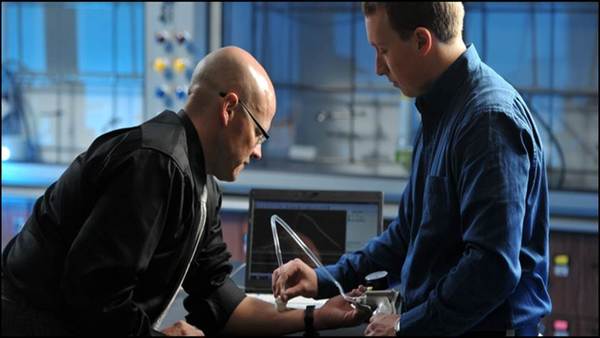Gregory Crawford, a Physics professor and Dean of the College of Science, is working with ESTEEM student Sean McGee on a noninvasive device to determine the ages of bruises on the skin.

The technology aims to provide objective data for physicians, social workers, and law enforcement who are dealing with potential child abuse cases. No such tool now exists, and responsible professionals must make highly subjective judgments that sometimes contradict parents’ explanations for the wounds on the child.
McGee, who graduated from Notre Dame with a double major in preprofessional studies and music, is creating a business plan for the technology that Crawford and his colleagues have developed. The device uses spectrometry to detect tiny differences in the color of a bruise as it changes over time, allowing users to pinpoint the date that the injury occurred and compare it to the parent’s story – potentially avoiding repeated abuse.
“Sean is passionate about finding a solution to this horrible problem, and his creativity, analytical skills, and entrepreneurial spirit are a tremendous asset to our work,” says Crawford, who has started companies in the past based on his research discovery, one in the area of drug discovery and the other in non-invasive hemoglobin determination. “Starting a company is no easy task; it takes perseverance, courage, and a sense of not being afraid to fail, a mindset that everything is possible and that hard work pays off – all values virtues possessed by Sean.”
“One aspect of the ESTEEM program is to provide faculty with a mechanism to assist them in commercialization — the program creates a win-win situation,” Crawford says.The technology also holds promise for diagnosing other conditions. Any application involving a way to use hemoglobin as a diagnostic signal is a good fit for this technology, including non-invasive hemoglobin testing in the field; twin-twin transfusion syndrome, which occurs in some mothers who are bearing twins; and possible applications in dermatology, tooth whiteness, and the severity of hot flashes in women undergoing menopause. Wherever there is a simple access point, such as skin, gums, or the conjunctiva that lines the eyelids, the technology might be useful for developing even more non-invasive applications.
“Faculty members, with so many other commitments and responsibilities, do not necessarily have the time to spend on commercialization so ESTEEM students help them and the University think through the prospects of the technology through a deep-dive in due diligence on marketing, intellectual property, business plan, and so forth. That is win No. 1.
“Win No. 2 is that the ESTEEM students are the very first to see the technology and think about commercializing it – in a sense, they are the first to see the future. In my case, I have very little time to take time out to start a company. Sean has done an extraordinary job at packaging the idea for the marketplace and making all of the necessary connections needed to form an actual Notre Dame spin-off company.”